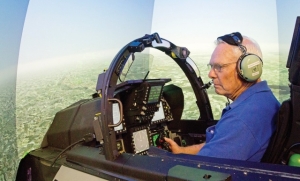Legendary pilot visits Seymour Johnson AFB
By Steve Herring
Published in News on October 13, 2014 1:46 PM

News-Argus/STEVE HERRING
Retired Air Force pilot Bob Pardo tries out the F-15E flight simulator during a Friday visit to Seymour Johnson Air Force Base. Pardo is an Air Force legend known for the "Pardo Push" in which he used his damaged F-4 jet to help push his wingman's crippled jet out of enemy airspace during the Vietnam War.
Robert "Bob" Pardo has never forgotten the lesson he learned at his father's knee -- when a friend needs help, you help.
Pardo, 80, a Vietnam fighter jet hero, spent the day Friday at Seymour Johnson Air Force Base, taking a turn in an F-15E flight simulator and visiting with airmen. He later served as the keynote speaker at a graduation ceremony for the base's basic course students.
"It's not every day that you get to work with a living legend," said Lt. Col. Chris Kreske. "It's fantastic. He really is the embodiment of what we call fighter pilot ethos, warrior ethos."
Pardo is famous in fighter pilot circles for a maneuver he came up with during a sortie over enemy territory that enabled two fellow pilots to make it back safely.
The "Pardo Push" helped another fighter jet that was losing fuel rapidly and threatening to flame out.
It was March 10, 1967 and Pardo, a captain, was flying an F-4 Phantom.
For days, heavy rain had grounded a mission to bomb North Vietnam's only steel mill in Thai Nguyen, 30 miles north of Hanoi. Then, the weather broke and the mission was on.
Pardo and 1st Lt. Steve Wayne were in one aircraft. First Lt. Robert Houghton and Capt. Earl Aman were in the other.
Both aircraft received major damage during the attack, but Aman's aircraft suffered the worst and it was apparent that his jet might not make it back to base.
Pardo and Wayne knew that their comrades would be killed or imprisoned if they were forced to eject so deep in enemy territory. There was nowhere to hide in the rice paddies below, but if they could make it into Laotian air space they could eject and use the jungle to evade capture.
"I thought perhaps I could put the fuselage of my airplane up against his and give him a piggyback," Pardo recalled. "As I got about within one foot of his airplane, the nose of my airplane started coming up."
At first Pardo though it was suction from the other aircraft pulling is up. But then he realized that the downwash coming off the other plane was the cause.
He backed off and told Aman to deploy and eject the plane's drag parachute.
Pardo said he thought he could position the nose of plane into the area where the chute had been to provide the needed push.
But that didn't work, either.
Next, he told Aman to lower the plane's arresting tail hook.
"OK. What do we have to lose?" Pardo said. "So he put the tail hook down. We eased in very gently and put it on the windshield. This was after he had flamed out."
The action drastically reduced Aman's rate of descent.
However, the canopy glass began to crack under the strain. So Pardo maneuvered his aircraft so that the hook would rest on the area in front of the canopy.
He was forced to adjust his position as the tail hook kept slipping several inches at a time.
Pardo estimates that Aman's aircraft would only have been able to have made 30 miles on its own. But with the added push from Pardo's aircraft, now flying on just one engine, it went somewhere between 50 and 88 miles.
The maneuver became known as Pardo's Push.
Pardo said what they had been through didn't really hit him until they got to the hospital.
"I am sitting there, drinking a cup of mission whiskey the flight surgeon gave us, and I started crying," he said. "Big tears were just rolling down my face.
"The doc comes over and says, 'What's the matter?' I said, 'That is the first scratch that I have ever put on an airplane, and I scratched the whole airplane.'"
The doctor try to reassure him by saying the enemy, not Pardo, had done that.
"Well, that didn't make me feel a whole lot better," he said. "But that is the only airplane I ever put a scratch on and I flew for 51 straight years."
Pardo said he never regretted what he did for his friends, even though he was threatened with a court-martial by an Air Force leadership that was sensitive to combat losses. His wing commander defended him and Pardo returned to flying.
There were no commendations, but Pardo said that didn't bother him.
However, in 1989 the four airmen received long overdue recognition.
Aman and Houghton received the Silver Star for continuing to press their attack even though their aircraft had sustained severe damage.
Pardo and Wayne also received Silver Stars for their actions.
